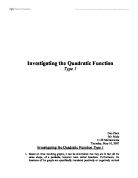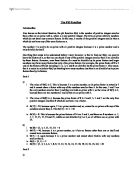Investigating the Quadratic Function
Type 1
Dan Plant
Mr. Maly
11 IB Mathematics
Thursday, May 10, 2007
Investigating the Quadratic Function Type 1
- Based on three resulting graphs, it can be determined that they are in fact all the same shape, of a parabola, however have varied locations. Furthermore, the locations of the graphs are specifically translated positively or negatively vertical according to the constant added or subtracted to the variable (x2). These three graphs may be generalized by the following statement; adding a positive or negative constant h will shift the graph vertically h units in the function y = (x2)+h. (Refer to attached graphs)
- Based on the three resulting graphs, it can be determined that they are in fact all the same shape, of a parabola, however they have varied locations. Furthermore, the locations of the graphs are specifically translated positively or negatively horizontal according to the constant added or subtracted directly to the variable x. These three graphs may be generalized by the following statement; replacing x in a function x2 with the expression (x – h), where h is positive or negative the graph will be translated to left or right respectively h units. (Refer to attached graphs)
- The vertex of the equation y = x2 is (0,0). Therefore, the vertex of y = (x – 4)2 + 5 is (4,5) based on previous conclusions above. Using the information gathered above, the translation values (h,k) are (4,5). Thus, the whole function would be moved horizontally +4 units and vertically +5 units. Therefore proving, the original vertex of (0,0) would become (4,5).
- (a) In order to articulate the expression x2 – 10x + 25 in the form (x – h)2 , it is required to complete the square. The expression x2 – 10x + 25 is a perfect square thus x2 – 10x + 25 = (x – 5)2.








